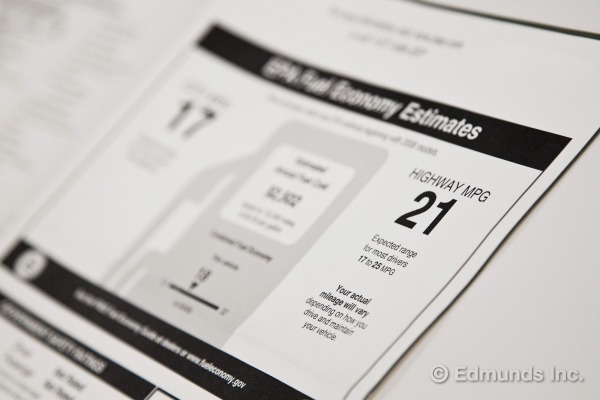
Fuel economy is a factor that influences the purchasing decisions of many car shoppers. Knowing a vehicle's fuel efficiency not only gives you a better idea of the monthly costs of the vehicle, but can also help you decide between two models.
If you haven't purchased a car in a while, you might not know exactly where to find this information. We've listed a number of resources to help you look up and compare a vehicle's miles per gallon (mpg). We'll also tell you what information is most important to your buying decision.
Window Sticker
If you're at a dealer and are browsing the lot, you can find a vehicle's fuel economy numbers in the EPA section of the window sticker. The EPA label will have three main fuel economy numbers: city, highway and combined mpg.
If the carmakers had their way, they would have you believe that their vehicles always get the highway mpg rating. But in the real world, few cars will actually achieve this number. Most cars will only get this kind of fuel economy on an open road, in perfect conditions and at a certain speed. But in the real world, we drive on both city streets and highways. We get stuck in traffic and we drive in all sorts of temperatures. This is why the combined mpg rating, rather than highway or city, is a more accurate representation of the vehicle's fuel economy. Window stickers on 2013 model-year and newer vehicles are required to have the EPA's new fuel economy label. This label made the combined mpg figure more prominent, as well as adding such useful information as annual fuel cost estimates and greenhouse gas ratings.
Edmunds Car Reviews
The Edmunds Car Review section has detailed stats on nearly every vehicle out there. Once you've selected a vehicle, the fuel economy information is available in three places. The city and highway mpg numbers are located in the center of the page, under the "Features and Specs" section. If you want the combined mpg, you can find that in the center of the model review, under the heading "Powertrains and Performance." Finally, you can get more detailed information in the "Gas Mileage" section on the right side of the page.
If you click on the "Calculate Yearly Fuel Costs" link, you'll go to a page where you can see estimated annual fuel costs and how driving more in the city can impact your fuel economy. Click on the "Edit" button to input your ZIP code and annual mileage, then move the slider to indicate the percentage of miles you drive in stop-and-go traffic. Edmunds tracks the price of fuel based on the ZIP code entered.
Fuel Economy.gov
The U.S. Department of Energy's Web site, Fueleconomy.gov, is one of the best tools for looking up and comparing mpg. You can search for the mpg of any vehicle as far back as 1984. The agency also retroactively adjusted the mpg ratings for pre-2008 vehicles to account for the Environmental Protection Agency's revision of how it measures and reports fuel economy. This adjustment lets you make apples-to-apples comparisons between pre- and post-2008 vehicles. For fun, you can also look at what the mpg looked like before the formula was recalculated.
This site offers customization features that are similar to those on Edmunds but with a few notable differences. "Unofficial MPG Estimates" shows you what people are getting in the real world.
The next few tables show you a variety of results, such as how much it will cost to fill the tank, the cost to drive 25 miles and the size of the fuel tank.
If you are interested in seeing the vehicle's environmental impact, click on the "Energy and Environment" tab. You'll get information ranging from annual petroleum consumption to an EPA smog rating.
Carmaker Web Sites
You might think that a carmaker's Web site is the best place to get information on a vehicle's fuel economy, but based on Edmunds research, you will get mixed results. If you happen to be looking at a fuel-efficient vehicle, some automakers will prominently display its mpg. Sometimes, though, you may only see the highway mpg.
If a vehicle is not known for its fuel efficiency (a full-size SUV, for example) you'll have to dig through the specifications page to find mpg figures. In many cases, the combined mpg figure is not listed at all.
An Alternative to MPG
The current miles-per-gallon system of measuring a vehicle's fuel efficiency is by no means perfect. In fact, it creates an inaccurate perception of fuel consumption. In "The Truth About Fuel Consumption," Senior Consumer Advice Editor Phil Reed gives this scenario as an illustration of the problem:
"If you were to trade in a car getting 12.5 mpg for one getting 25 mpg, it would obviously deliver fuel economy that was twice as good. But if you later traded that car getting 25 mpg for one getting 50 mpg, that exchange would not save you twice as much."
It may take some time for this concept to sink in, but you're going to start seeing more "gallons-per-100 miles" figures in the future. The new fuel economy labels mentioned earlier will display the "gallons-per-100-miles" figure under the combined mpg number to provide additional information for the consumer. Our article on the subject can give you a head start on understanding this concept.
If your research leaves you debating whether you should get rid of your car for something more fuel-efficient — or you want to find which more efficient car makes more economic sense for you — take a look at our Gas-Guzzler Calculator. It will help you crunch the numbers and determine the right course of action.